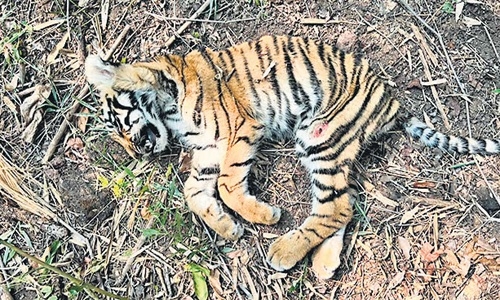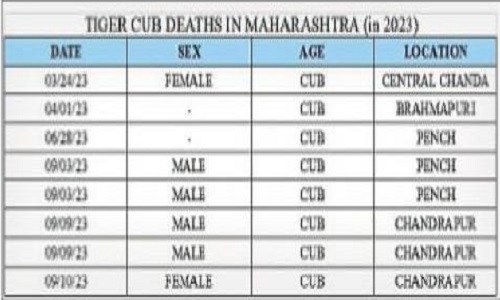Eight tiger cubs dead in nine months, highest in 3 yrs
11 Sep 2023 07:44:50

By Kaushik Bhattacharya
Maharashtra has witnessed eight tiger cub deaths in last nine months of 2023, which is the highest in last three years. All the eight tiger cub deaths took place in Chandrapur and Nagpur Forest Divisions, revealed the tiger mortality data of National Tiger Conservation Authority (NTCA). The population of big cats is on the rise in the country. The latest count puts the number of tigers in the State at 350, compared to 287 in 2018. However, the mortality has also increased in last four years in the State. According to NTCA, in 2023, total 33 tigers, including 8 cubs, 4 sub-adults, and 21 adult deaths were recorded in the last nine months which is the highest in three years. In 2022, total 28 tigers died, of which 7 were cubs, 3 were sub-adults and remaining were adults. Similarly, in 2021, the toll was 27 which included 5 cubs, 3 sub adults, and remaining were adult tigers. Maharashtra, which has six Tiger Reserves, witnessed all the tiger deaths in Vidarbha region only in last three years. Out of eight tiger cub deaths this year, five cubs died in September itself. In this infant mortality list, four cubs were from Chandrapur, one was from Brahmapuri and three were from Pench Tiger Reserve.

Scientific studies have shown that, under natural conditions, infant mortality is very high in tigers and other large carnivores. Up to 40-60% of cubs born will die due to natural reasons in the first 15 months. Even the Forest Department considers the high mortality of tiger cubs as natural. “Though the monitoring of tiger population is very good in Reserve Forests of Maharashtra, there is an utmost need to enhance extensive monitoring in territorial areas too,” Ajinkya Bhatkar, Honorary Wildlife Warden, Nagpur told The Hitavada. “It is right that infant mortality in tigers is mostly because of natural reasons, but there should be a study to explore other reasons also for such deaths by experts,” he added. Like Tiger Reserves, department should install camera traps in territorial areas to monitor the tiger movement. It will also help to curb the deaths due to electrocution that mostly takes place in territorial areas, Bhatkar added. “State Government should also form a separate fund for wildlife management in territorial area to strengthen monitoring and other activities for wildlife conservation,” Bhatkar explained.
Normally, starvation due to abandoning by the mother is the major cause of tiger cub death. Now electrocution, poaching and reduced prey base are also some major reasons behind cubs death which should be explored by experts and the Forest Department. The recent tiger cub deaths that took place in Chandrapur and Pench are due to starvation. According to sources, mothers of these five cubs are still missing and the Forest Department is searching for both the tigresses. However, the Forest Department is conducting the search operation with hope that both tigresses are alive.